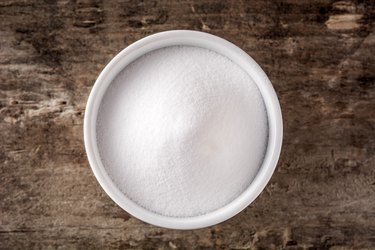
Baking soda makes cookies, quick breads and biscuits rise in the oven, so you get a final product with good volume. If you find you're out of the leavening agent when you're in the midst of a recipe, you can use other ingredients as a substitute for baking soda in cookies and other baked creations.
Tip
Baking powder is one possible replacement for baking soda in cookies. Self-rising flour is another.
Video of the Day
How Baking Soda Works
This seemingly minor ingredient in your cookies is actually essential. It gives them their final flavor and lightness.
Video of the Day
Baking soda, or sodium bicarbonate, is an alkaline powder. When blended with moisture and an acid — such as yogurt, brown sugar or cocoa — the mixture creates carbon dioxide bubbles. These make the batter of cookies, such as our Chocolaty Chia Cookies, rise and lighten in texture as they bake.
Baking soda doesn't add any calories to recipes, but can add small amounts of sodium. A 1/8-teaspoon serving contains 160 milligrams of sodium, according to the USDA.
Baking soda is even used as a home remedy antacid for gastric upset by some people. You're probably best keeping it in your cookies, however, explained the Journal of Clinical Pharmacy and Therapeutics in February 2014. People often use the soda at home improperly, such as for beating drug tests (it doesn't work) or as treatment for urinary tract infection. When misused, the compound can result in serious electrolyte and acid-base imbalances.
Read more: Pumpkin Carob Chip Cookies
Baking Powder as a Substitute
Baking powder is a common alternative leavening agent that may be used as a substitute for baking soda in cookies and other baking. It's common for people to have this powder in the pantry too.
Beware that baking powder doesn't have as much leavening power as plain baking soda. According to the Yale National Initiative, baking soda is four times as powerful as baking powder, so 1/4 teaspoon of baking soda will leaven just as much as 1 teaspoon of baking powder.
Baking powder doesn't have the salty taste of baking soda either, so you may have to add more salt, by a pinch or two. Baking powder also has an acidic ingredient included, in the form of cream of tartar. You may want to replace a small amount of the acidic ingredients in your recipe with something more neutral, but for most basic cookie recipes, a little extra acid shouldn't vastly affect the outcome.
Read more: Pulse Chocolate-Chip Cookies
No Baking Soda or Powder?
Self-rising flour may be an ingredient you have in your cupboard. You'll need to make adjustments to your cookie recipe if you choose to use this as a substitute for baking soda in cookies.
Self-rising flour is a combination of all-purpose flour, baking powder and salt. Each cup of self-rising flour contains about 1 teaspoons of baking powder and 1/4 teaspoon of salt.
When baking your cookie recipe, you'll want to replace some of the acidic ingredients with more neutral ones — such as milk instead of buttermilk — to keep the flavors balanced. The baking powder in the self-rising flour has acid included already.
Using self-rising flour instead of baking soda, regular flour and salt, and correctly adjusting the acidic compounds in the recipe, can be tricky. This may be a substitution best-suited to an experienced baker and not a novice. You may need to experiment a bit to get the flavors just right.
Read more: 10 Desserts That Won't Derail Your Diet